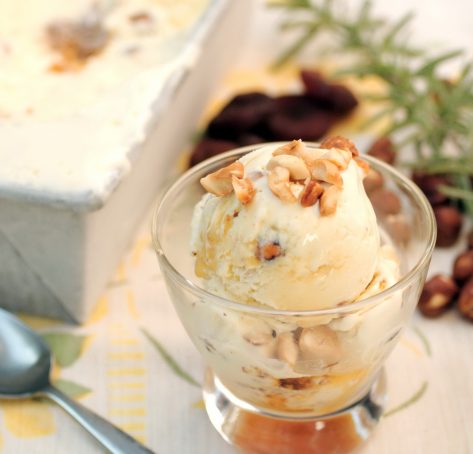Rosemary and Toasted Hazelnut Ice Cream with Apricot Swirl
It is with guilty pleasure that I write this: pleasure because it’s an ice cream fable; guilt because it has diverted my attention from Odette, a dear French lady with decades of cooking skills whom I’ve written about three times so far.* There are so many more Odette stories to tell and Odette recipes to share.
For the last couple of months, in a spare hour here and there, I have been slowly transcribing and translating what Odette said about her life in an audio interview I did with her this summer. I’m particularly keen to decipher what she says about living and eating in Nazi-occupied Paris when she was a young girl. She recounted a war-time food story that is impressed upon her memory. One day her mother returned home from the marché noir (black market) with the only thing available that day: un gros chou (a large head of cabbage). As Odette watched, her mother proceeded to do something unusual with that head of cabbage. I can’t make out what happens next in the story, but I can guess.
A few summers ago, Odette had me and my husband, Mike, over for one of her formidable lunches, which always consist of at least three courses and often five. That day, the perfectly dressed green salad was made with the most tender and flavorful escarole imaginable. I made a few “mmm” sounds and, pointing to the salad and using the simplest form of compliment in French, the only one I was capable of, I expressed my satisfaction: “C’est délicieux” (“It’s delicious”). Odette’s usually bright eyes took on an extra glint of excitement. She leaned in to convey a secret that is shared with an inner circle of food devotes, and said, “I made the salad for you with only the best leaves. The tough, outer leaves are for the rabbits.”
I suppose Odette’s mother used every part of that head of cabbage, parts that in better times would have been for the rabbits. Since it is just at the point where Odette relays the pivotal part of the story that my poor French fails me, I’m going to have to call in the professionals.
* * * * * * * * * * * * * * * * * * * *
When a long-haul project moves at an escargot’s pace, such as a two-in-one transcription and translation job, I find myself looking for some faster diversion that, in its completion, gives me the momentary satisfaction of having accomplished something.
Enter Jamot the rabbit. Last summer Odette presented us with one of her prized embroideries. This one pictures a rabbit. But not just any rabbit doing any old thing. This rabbit is wearing plaid pants and a solid brown jacket and sports a splash of peacock-patterned fabric, which is . . . . a shirt, a scarf, a jacket lining? I’m not sure. When you turn the embroidery over, there on the back, handwritten on a piece of tape, is an account of his activity, which explains why he is carrying a basket: Le lapin va au marché à Pontlevoy (The rabbit going to the market in Pontlevoy). (This is clearly a French rabbit because no American male rabbit would be comfortable enough with his masculinity to carry a basket to market.)
Since this rabbit shops in Pontlevoy, the village that Odette her husband, Roger, call home, Mike and I assumed that he is from Pontlevoy, as well. This, and his name, was later confirmed in a drawing we received that shows Jamot engaged in another of his favorite activities: scootering. The following, written by Jamot and translated here for you, was jotted down in the upper left corner of the drawing: My name is Jamot—rabbit of Pontlevoy.
Taking Jamot’s sprightly lead, I took a nosedive down the rabbit hole of herb-infused ice cream. I was already partly down it, having just come off the high point of making from-scratch mint chocolate chip ice cream using fresh mint. That experiment put me into an herb and ice cream frame of mind, and got me to looking about my courtyard at the many other pots that contain herbs, which lead me to consider rosemary. Though perennial in the right conditions, I haven’t yet been able to get a potted plant through the winter here in Richmond, Virginia. It begged me to choose it for my new herb-infused ice cream experiment before the first hard frost. (Around here, rosemary planted in-ground is another story; I have seen plenty of established bushes, nay, hedgerows, of rosemary with gnarled trunks the size of small trees in my neighbors’ front yards.)
It was Jamot who suggested the addition of hazelnuts. He ought to know; rabbit and hazelnuts is a classic pâté combination in France. Authors Karen Page and Andrew Dornenburg, in their book The Flavor Bible, are who gave me the idea of throwing apricots into the mix. So was born Rosemary Ice Cream with Roasted Hazelnuts and Apricot Swirl. Now back to figuring out what exactly Odette’s mother did with that head of cabbage.
Recipe for Rosemary and Toasted Hazelnut Ice Cream with Apricot Swirl
Makes 2 quarts
I love it when recipe testing reveals some simple truth in absolute, unequivocal terms, such as this one:
Hazelnuts want to be toasted.
Yes, indeed—only after toasting do they really shine. Before then, they don’t taste like the iconic nut that made Nutella famous or has Italians reaching for a biscotti. Compared to a toasted hazelnut, the flavor of a raw hazelnut is muted and one-dimensional: it trundles along, sort of flatlining, and then exits the same way it came in. The flavor of a toasted hazelnut builds, rewarding patient mouths with the sought-after hazelnut flavor only in the last moment. What’s more, the texture of a raw hazelnut is a little mealy, and not crunchy in the least. I learned all of these things while developing this ice cream recipe. But that is not all.
I also learned that since hazelnuts skins are slightly bitter, hazelnuts want their skins removed, or to be precise, they want about 50 percent of their skins removed. This is the amount you’ll be able to remove when you use the toasting method to remove hazelnuts skins. And that is the method to use. (I’m convinced that the remaining 50 percent of skins that stubbornly cling to hazelnuts after toasting are part of a master plan; it’s a known fact that a bit of bitterness adds welcome complexity to foods and is a natural balance to fat, which hazelnuts have plenty of.)
Whatever you do, don’t be tempted to use the boiling water and baking soda method to remove hazelnut skins. With a 99.9 percent skin removal success rate, it’s an impressive technique, but you’ll lose 100 percent of the classic hazelnut flavor you are after. I suppose it ends up in the boiling water. Even after toasting the nuts after boiling and skinning them, which is a requirement, they never become as crunchy as the toasted, never-boiled, hazelnuts.
INGREDIENTS
For the ice cream base:
- 1 large sprig fresh rosemary (8 to 10 inches long)
- 1¾ cups whole milk
- 2 cups heavy cream
- Healthy pinch of coarse sea salt
- 6 large egg yolks
- ¼ cup sugar
- ½ cup mild-flavored honey
For the apricot swirl:
(Makes 1 cup)
- ¾ cup Muscat wine, or other sweet white wine, such as Riesling
- ¾ cup water
- 1 vanilla bean (about 6 inches long), split and seeds scraped
- 2 wide strips orange zest
- 5 ounces dried apricots (about 1 cup)
- ¼ cup mild-flavored honey, plus more for the apricot syrup
- 3½ ounces raw hazelnuts (about ¾ cup)
For garnish:
- Apricot syrup (from above)
- Apricot syrup-infused whipped cream (optional)
- Chopped toasted hazelnuts (from above)
- Flake sea salt
INSTRUCTIONS
Make the ice cream base:
- Cut the rosemary sprig in half and place in a heavy bottom saucepan along with the milk, cream, and salt. Heat slowly over moderate heat until small bubbles form around the edge of the pan and steam is rolling off the surface, then remove the pan from the heat, cover, and infuse for 1 hour.
- Pour the steeped milk and cream mixture through a fine-mesh sieve into a clean heavy bottom saucepan. Press against the rosemary to extract any remaining liquid. Discard the rosemary.
- Return the infused milk and cream mixture to medium heat and heat until steam is rolling off the surface and bubbles appear around the edge of the pan.
- Meanwhile, in a heatproof mixing bowl, vigorously whisk the egg yolks with the sugar until pale-colored and foamy, 2 to 3 minutes.
- Whisking constantly, gradually add, ladleful by ladleful, half of the hot milk-cream mixture into the yolk-sugar mixture to temper the eggs.
- Add the tempered yolk-sugar mixture to the saucepan with the remaining milk and cream mixture and whisk to blend.
- Set the pan over medium-low heat and cook, stirring constantly, with a wooden spatula in a figure eight motion, until it reaches 170°F. At this point the cream will coat the back of the spoon and be noticeably thickened. (To sterilize the egg yolk, keep it at 170°F for 1 minute.) When stirring the custard, be sure to get the spoon into the bottom corners of the pan as that is where the egg will coagulate first. Do not let it come to a boil; if the mixture is heated to 180°F it will curdle.
- Strain the custard through a fine-mesh strainer into a bowl, then add the honey and stir until dissolved. Set the bowl with the custard in a bowl of ice water. Stir until cooled, then refrigerate for a minimum of 8 hours (or overnight) to chill thoroughly.
Macerate the dried apricots:
- Bring the wine, water, vanilla, and orange zest to a boil in a small saucepan over medium-high heat. Continue to boil for 5 minutes to allow the flavor of the vanilla and zest to infuse the liquid. Add the apricots and lower the heat to maintain a simmer for 2 minutes, the remove the pan from heat. Add the honey and stir until dissolved.
- Let the mixture cool, then bottle and place in the refrigerator for a minimum of 8 hours (or overnight) to chill completely and allow the flavors to infuse further.
Toast and skin the hazelnuts:
- Preheat the oven to 350°F. Line a mixing bowl with a clean towel. Place the hazelnuts on a sheet pan and toast in the oven for 15 to 20 minutes, shaking the pan one or twice during baking, until the hazelnuts are highly aromatic and the skins have turned dark brown (don’t let them blacken). Dump the nuts into the center of the towel and wrap the ends around it; let sit for 5 to 10 minutes.
- Vigorously rub the nuts against each other in the towel to loosen the skins. This will take several minutes of rubbing and, at best, you will remove about 50 percent of the skins. Once the skinned nuts have completely cooled, chop them and place in the refrigerator until ready to use.
When all of the components are prepared and fully chilled, process the ice cream base in an ice cream maker, following the manufacturer’s instructions.
While the ice cream is churning, make the apricot swirl: Remove the apricots from the macerating liquid and put them and 3 tablespoons of the macerating liquid into a food processor and pulse until you have a thick puree, about the consistency of a thick semi-chunky applesauce. If the mixture isn’t coming together into thick puree, add up to 1 additional tablespoon of the macerating liquid. Reserve the rest of the macerating liquid to make a syrup for the ice cream.
During the last couple minutes of churning, add all but ⅓ cup of the chopped hazelnuts to the ice cream; set the reserved hazelnuts back in the refrigerator for use as garnish.
Once the ice cream is churned, scoop about one-third of it into a 2-quart freezer-safe container and spoon about one-third of the apricot puree on top of the ice cream. Immediately swirl in the puree, using a chop stick or a skewer. Repeat twice more.
Place in the freezer to set up, or “cure,” for at least 4 hours.
While the ice cream is curing in the freezer, make a syrup using the leftover macerating liquid: Strain the liquid into a small saucepan; discard the vanilla and orange peel. Bring the liquid to a boil over high heat, then lower the heat to medium and simmer until the liquid is reduced by two-thirds and lightly coats a spoon, about 10 minutes. Taste and add a touch of honey to sweeten the syrup, keeping a sweet-tart balance; stir the honey until it is dissolved. Allow the syrup to cool to room temperature, then bottle and place in the refrigerator to chill.
To make infused whipped cream using the apricot syrup, add 1 tablespoon of the chilled syrup to ½ cup heavy whipping cream and whip until soft peaks form.
To serve, remove the ice cream from the freezer and allow it to soften for 5 or 10 minutes. Scoop into bowls and drizzle on some of the syrup, then add a dollop of whipped cream, if desired. Sprinkle on some of the reserved chopped hazelnuts and finish with a tiny pinch of flake sea salt.
Tip: Here is a strategy for making this ridiculously complex ice cream recipe come together easily the day you want to make it and become one of a select number of I-will-go-to-any-length ice cream fanatics to enjoy this unique and fanciful flavor: The evening before you plan to churn the ice cream (or the morning of, if you’re an early riser), make the ice cream base, macerate the dried apricots, and toast, skin, and chop the hazelnuts.
*To read the three stories I’ve written previously about Odette, click here, here, and here.




Dear Chef Holly,
1You are the most ambitious creator of a most curious combination. I only wish I had been on hand to taste your final batch for it must have been an extreme treat. Next time we talk I want to hear a verbal discription of the icecream on the palette. I’m trying to imagine the flavor. I am thinking the combination using apricot must be fabulously pleasant.
Another delightful article I have had the pleasure of reading. Thank you for your creativity and your gracious spirit. Always yours, mom